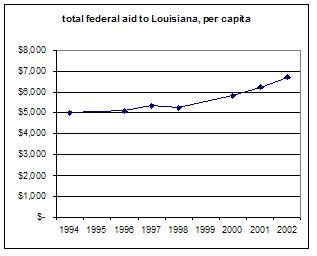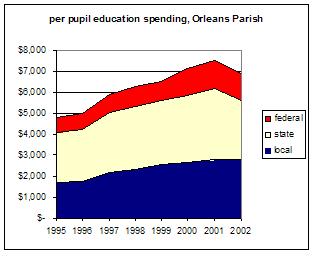In the aftermath of Katrina, an emerging line of argument goes like this: Bush is an anti-government conservative. Anti-government conservatives cut spending. Therefore, Bush cut spending. And the flooding has revealed the vulnerability of poor people when government spending is inadequate. I suspect that the real story is somewhat different. Bush is a profligate spender who borrows to finance rising expenditures. Cuts are coming, forced by the debt, but they have not happened yet. Therefore, it is generally inaccurate to attribute current social problems to Bush’s spending cuts. The real culprits are decades, even centuries, of under-investment, plus very poorly managed government–both in big cities and, since 2000, at the federal level.
The full story is probably somewhat more complicated, since there have been federal cuts in some programs. I wish that financial data were more widely cited in the debate about what Katrina “means.” In my limited discretionary time, I have created two graphs, both of which end in 2002. (More recent data are not easily found.)
The first shows that total federal spending per capita increased in Louisiana through 2002, although these numbers are not adjusted for inflation. Consistently, about 10% of the annual spending is for defense.
The second graph shows that spending per student in the Orleans Parish public schools rose, but then fell in the 2002-3 school year, mainly because of a drop in state support. Again, these figures are not adjusted for inflation.
I acknowledge that these are just snippets of information, and I’d welcome more detail about any actual Bush spending cuts that might have affected citizens of New Orleans.

